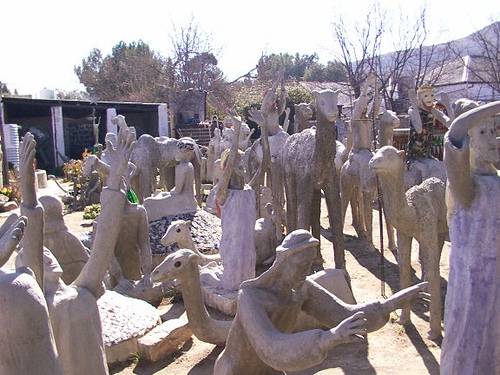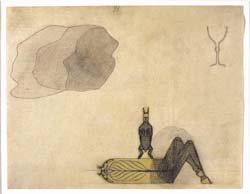ucalegon
n. a neighbor whose house is on fire
Author: Greg Ross
Charley Parkhurst
Excerpt from an obituary for stagecoach driver Charley Parkhurst, published in the San Francisco Morning Call, Dec. 28, 1879:
He was in his day one of the most dexterous and celebrated of the famous California drivers ranking with Foss, Hank Monk, and George Gordon, and it was an honor to be striven for to occupy the spare end of the driver’s seat when the fearless Charley Parkhurst held the reins of a four- or six-in-hand …
It was discovered only afterward that “One-Eyed Charlie” had been a woman, born Charlotte Darkey Parkhurst in Vermont in 1812. Posing as a man, she had gained a reputation as one of the best stagecoach drivers on the West Coast.
More than that, her name (as Charles Darkey Parkurst) is listed in the Santa Cruz voter rolls for Oct. 17, 1868 — which means she may have been the first woman to vote in California.
The Owl House

Deciding that her life was “dull,” Helen Martins went a little crazy in 1945 and began filling her garden with sculptures of owls, camels and people. She said she drew her inspiration from Blake, the Bible and Omar Khayyam, but she also pointed most of the figures eastward to reflect an obsession with the Orient. And she decorated the house’s interior walls with crushed glass.
Martins was derided during her lifetime, but the house has been preserved and is now a national monument in South Africa.
Love Padlocks

In the 1980s, in the Hungarian city of Pécs, lovers began to clamp padlocks to this wrought-iron fence as a symbol of their commitment.
Now that the fence has filled up, people have begun attaching locks to fences and statues throughout the town center, and the custom has spread to Hungary, Latvia, Italy and Japan.
“Love is a lock that linketh noble minds,” wrote Robert Greene, “faith is the key that shuts the spring of love.”
August Natterer

Schizophrenic artist August Natterer (1868-1933) may have been a visionary, but it’s hard to tell.
For example, in this drawing, Axel of the World, With Rabbit (1919), he said that the rabbit represents “the uncertainty of good fortune. It began to run on the roller … the rabbit was then changed into a zebra (upper part striped) and then into a donkey (donkey’s head) made of glass. A napkin was hung on the donkey; it was shaved.”
Seneca wrote, “There is no great genius without some touch of madness.”
Limerick
There was a young lady named Susie
Whose surname said she was a floozie.
Cathouse was the name;
It caused her such shame
She chose to pronounce it Cathouse.
Bullseye
0.999… is the same as 1. Not just very close, but precisely identical:
a = 0.999…
10a = 9.999…
10a – a = 9.999… – 0.999…
9a = 9
a = 1
There’s no trick here. It’s just a mathematical fact that most people find deeply counterintuitive.
Bishop-Fish

Is there an aquatic church we don’t know about? Three centuries after John Stow’s sea monk escaped, a “bishop-fish” was caught and taken to the king of Poland. It gestured to a group of Catholic bishops, appealing to be released, and when they granted its wish it made the sign of the cross and swam away.
Another bishop-fish was reportedly caught near Germany in 1531. This one refused to eat and died after three days.
Swiss naturalist Conrad Gesner, who described it in his Historia Animalium, also refers to monk-fish caught off Norway and in the Firth of Forth. Someone ought to take up a collection.
Unquote
“It is a very sad thing that nowadays there is so little useless information.” — Oscar Wilde
The Ding Hai Effect
Adam Cheng isn’t very popular among stockbrokers. That’s because every time the Hong Kong actor stars in a new television show, there’s a sharp drop in global stock markets.
No one can explain it, but it’s happened eight times since 1993, when Cheng first starred as Ding Hai in the dramatic series Greed of Man. Only once, in 2004, has a new Cheng series not been accompanied by a drop in the stock market.
